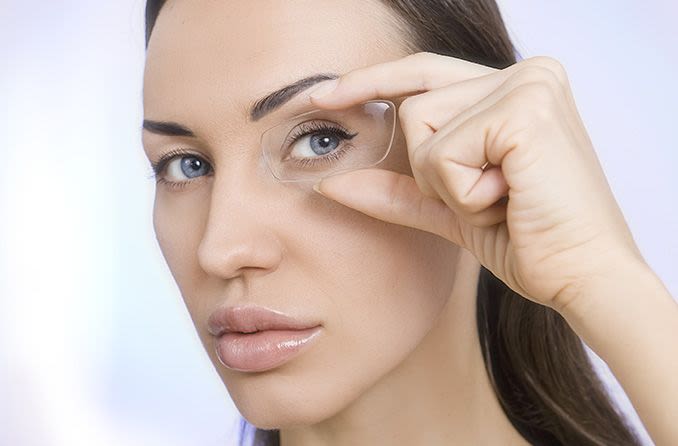Which eyeglass lenses are best for me and my vision?

Whether it’s your first time getting glasses or you’re just ready for a new pair, learning how to choose the best lenses for your frames is crucial.
Here are some key factors to consider when making your selection:
Lens materials
In the early days of eyewear, all lenses were made of glass. While glass offered great vision quality, the lenses came with a high risk of shattering.
Now there are many choices for lens materials, each with drawbacks and benefits. The most popular options include plastic, polycarbonate and Trivex.
CR-39 plastic lenses
If you’ve had vision problems your entire life, you probably had at least one pair of plastic lenses when you were growing up. Plastic lenses are inexpensive to manufacture and they won’t cost an arm and a leg if you need to replace them.
But just because plastic lenses are affordable, it doesn’t mean they’re low-quality. CR-39 plastic lenses weigh half as much as glass and offer great optics, so you’ll see through them with near-perfect clarity and without the fear of glass breaking in your eyes at any moment.
The downside is that plastic lenses are thicker than other modern lenses — especially if you have a strong prescription — so they might not fit your sense of style.
High-index plastic lenses
Not all plastic lenses are the same. Over the years, plastic lenses have become more sophisticated and offer more benefits than the trusty CR-39.
Today’s high-index plastic lenses are a great middle-ground of cost and comfort. They’re among the thinnest lenses available on the market, and they’re lighter than traditional CR-39 plastic lenses.
Polycarbonate lenses
If you live an active lifestyle or are buying glasses for your child, you’d do well with a pair of polycarbonate lenses. These lenses offer great impact resistance, so they can take pretty much anything you throw (or your child throws) at them.
That strength doesn’t come at the expense of weight, either. Polycarbonate lenses are some of the lightest lenses on the market, even lighter than high-index plastic.
Another great perk of polycarbonate lenses is that they naturally filter more than 99% of UV rays, so they’re a great option for you and your children to wear outside.
One downside to consider is that polycarbonate lenses are prone to chromatic aberration, which means you may see colored halos around objects when wearing your glasses.
Basically, the material these lenses are made from disperses light differently than other lenses. It’s most noticeable when you look at light sources through the periphery of your lenses.
Trivex lenses
You might have heard of Trivex, a lens material developed as an alternative to polycarbonate, by another name, such as NXT, Phoenix or Trilogy. They include all the perks of polycarbonate lenses with even sharper optics, including:
Highly impact-resistant material
Lightest-weight lens material on the market
100% of UV rays blocked
Superior clarity compared to polycarbonate
You can expect to pay a bit more for all of those benefits, so if cost is a factor, Trivex might not be the best choice for you.
SEE RELATED: Eyeglass frame materials: Metal, plastic and unusual
Prescription lenses
If you’re having vision problems at certain distances, your eye doctor will consider whether you need single-focus, bifocal, trifocal or progressive lenses when determining your eyeglass prescription.
Single-focus lenses offer the same magnification at all distances, while multifocal lenses are optimized to help you see nearby or far away. Progressive lenses, or “no-line multifocals,” provide a gradual shift in magnification power across the lens so there aren’t any of the “image jumps” you would find wearing bifocals or trifocals.
Lens treatments
Aside from material and prescription type, special coatings and treatments can offer additional perks to make your lenses just right. Here are a few options you might want:
Anti-scratch coating – This coating helps your lenses stand up to nicks and scratches. If you know your glasses will face a lot of wear and tear, this can help them last longer. Just remember: No coating can guarantee 100% scratch prevention.
Anti-reflective (AR) coating – Glare is a real concern for people with glasses. If you’re tired of reflections bouncing off your lenses, or if you find it hard to drive at night, AR coating is for you.
UV-blocking treatment – Most modern lens materials block UV rays naturally. For those that don’t, this coating helps bring them in line.
Photochromic treatment – Moving between bright and dimly lit environments can take a moment to adjust. This treatment makes that transition easier by helping your lenses adapt to the light in your new surroundings. Photochromic lenses also filter blue light, which is handy if you spend a lot of time in front of a computer screen and don’t want to buy a separate pair of computer glasses.
You don’t have to make all these choices alone. Ask an eye care professional which lenses will work best for you.
SEE RELATED: How to Put Lenses Back in Your Glasses
Page published on Saturday, January 18, 2020







